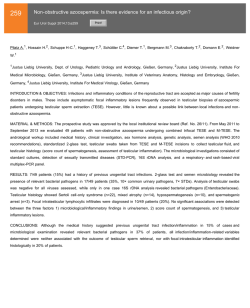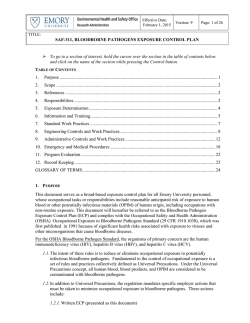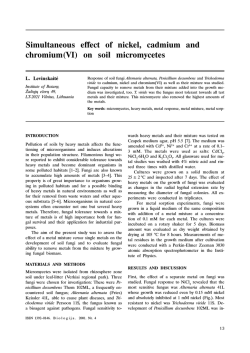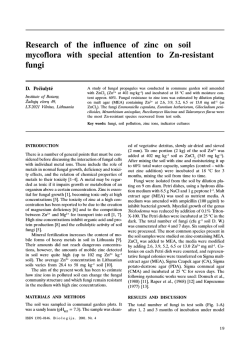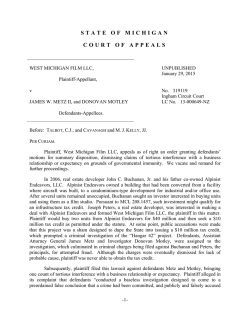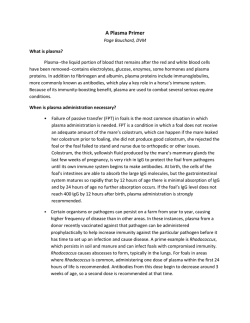
Filamentous pathogen effector functions: of pathogens, hosts and
Available online at www.sciencedirect.com ScienceDirect Filamentous pathogen effector functions: of pathogens, hosts and microbiomes Hanna Rovenich1, Jordi C Boshoven1 and Bart PHJ Thomma Microorganisms play essential roles in almost every environment on earth. For instance, microbes decompose organic material, or establish symbiotic relationships that range from pathogenic to mutualistic. Symbiotic relationships have been particularly well studied for microbial plant pathogens and have emphasized the role of effectors; secreted molecules that support host colonization. Most effectors characterized thus far play roles in deregulation of host immunity. Arguably, however, pathogens not only deal with immune responses during host colonization, but also encounter other microbes including competitors, (myco)parasites and even potential co-operators. Thus, part of the effector catalog may target microbiome co-inhabitants rather than host physiology. Addresses Laboratory of Phytopathology, Wageningen University, Droevendaalsesteeg 1, 6708 PB Wageningen, The Netherlands Corresponding author: Thomma, Bart PHJ ([email protected]) These authors contributed equally to this work. 1 Current Opinion in Plant Biology 2014, 20:96–103 This review comes from a themed issue on Biotic interactions Edited by Makoto Hayashi and Martin Parniske For a complete overview see the Issue and the Editorial Available online 28th May 2014 http://dx.doi.org/10.1016/j.pbi.2014.05.001 1369-5266/# 2014 The Authors. Published by Elsevier Ltd. This is an open access article under the CC BY license (http://creativecommons. org/licenses/by/3.0/). Introduction During early microbial colonization stages, plant cell surface-localized pattern recognition receptors (PRRs) recognize microbe-associated molecular patterns (MAMPs), such as fungal chitin, to activate immune responses [1,2]. In order to establish themselves, adapted pathogens secrete effector molecules that deregulate immune responses and facilitate host colonization. Simultaneously, hosts evolve effector recognition by novel receptors that reinstall immunity [1,2]. Consequently, effectors are subject to various selective forces that drive their evolution, leading to diversified effector repertoires between pathogen lineages. Functional characterization of effectors and determination of their contribution to the microbial lifestyle provides insight in relevant processes for host colonization. Current Opinion in Plant Biology 2014, 20:96–103 Plant pathogen effectors deregulate host immunity in various subcellular compartments Many pathogens initially enter the plant apoplast, which contains enzymes that hamper microbial colonization. For example, chitinases target fungal cell walls to release chitin fragments that activate immune receptors, leading to further chitinase accumulation to induce hyphal lysis. In turn, fungal pathogens secrete chitin-binding effectors to protect their cell walls and interfere with immune receptor activation [3–6]. The LysM domain-containing Ecp6 effector of the leaf mold fungus Cladosporium fulvum can outcompete host receptors through chitin binding with unprecedented ultrahigh (pM) affinity by intramolecular LysM domain dimerization [7]. Additionally, LysM effectors likely interfere with receptor dimerization that is required to activate immune signaling [7,8,9]. Although effectors that directly target chitinases have not yet been identified, some effectors target other apoplastic hydrolytic enzymes, such as proteases. For example, sequence-unrelated effectors of C. fulvum, the oomycete Phytophthora infestans, and the parasitic nematode Globodera rostochiensis inhibit tomato cysteine proteases including Rcr3 [10,11,12]. The closely related oomycetes P. infestans and P. mirabilis express an orthologous pair of host protease inhibitor effectors that are subject to positive selection, which was implicated in adaptation to unique protease targets in their respective host plants [13]. Besides protease inhibitors, P. infestans secretes the Avrblb2 effector that interferes with protease secretion [14]. The smut fungus Ustilago maydis inhibits apoplastic proteases via multiple effectors. While Pit2 directly inhibits cysteine proteases [15], Pep1 induces the maize cystatin CC9 that inhibits apoplastic proteases in turn [16]. Pep1 furthermore inhibits the maize peroxidase POX12 to perturb reactive oxygen species balances [17]. Thus, the plant apoplast is a dynamic battlefield for plant pathogens. In addition to apoplastic effectors, many pathogens deliver effectors that act inside host cells, although mechanisms that govern their uptake remain controversial [18]. The rice blast fungus Magnaporthe oryzae was shown to secrete various effectors that enter rice cells, and even move to non-infected neighboring cells, presumably to prepare these for infection [19]. The AvrPiz-t effector targets proteasome activity through interaction with the RING E3 ubiquitin ligase APIP6, leading to their mutual degradation and suppression of PRR-mediated immunity www.sciencedirect.com Filamentous pathogen effector functions Rovenich, Boshoven and Thomma 97 [20]. Effector diffusion from infected cells into neighboring cells was similarly observed for the U. maydis chorismate mutase Cmu1 that targets the shikimate pathway to channel chorismate into the phenylpropanoid pathway, thus adversely affecting salicylic acid (SA) biosynthesis [21]. U. maydis furthermore secretes the Tin2 effector to stabilize the maize ZmTTK1 kinase that controls anthocyanin biosynthesis, possibly to suppress tissue lignification [22]. Also the oomycete Hyaloperonospora arabidopsidis targets SA signaling by secreting a nuclear-localized effector that interacts with the mediator complex that controls interactions between transcriptional regulators and RNA polymerase [23]. Host transcription is furthermore perturbed by effectors that inhibit transcription factor translocation to the nucleus [24]. Additionally, nuclear-localized effectors may affect host immunity post-transcriptionally by suppressing the biogenesis of small RNAs in the host [25]. Interestingly, Botrytis cinerea was recently suggested to deliver even small RNAs into host cells to affect immune responses [26]. Finally, several effectors target host cell death mechanisms, such as P. infestans Avr3a and PexRD2. While Avr3a suppresses INF1-triggered cell death by stabilizing the U-box E3 ligase CMPG1 during biotrophic growth, PexRD2 targets the kinase domain of the cell death regulator MAPKKKe [27,28]. During later stages of infection, however, P. infestans relies on induction of host cell death as it switches to a necrotrophic lifestyle. Necrotrophic pathogens evolved effectors that actually induce cell death. An elegant example is provided by the Cochliobolus victoriae effector victorin that binds to thioredoxins including TRXh5, which is required for redox control of the transcriptional immune regulator NPR1. TRXh5 binding activates the NB-LRR-type immune receptor LOV1, facilitating necrotrophic exploitation of host cell death by C. victoriae [29]. In conclusion, although information for the vast majority of pathogen effectors, particularly of filamentous pathogens, is still lacking, effector molecules are highly versatile. Clearly, recently uncovered functions revealed that virulence effectors, despite the finding that they converge onto pivotal elements of the plant immune system [30], can deregulate any step of immunity in any cellular compartment (Figure 1 and Table 1). Endophytes and mutualists use effectors to suppress host immunity too Like pathogens, commensalistic endophytes and mutualists develop intimate host–plant associations. During initiation of such symbioses, PRRs continue to perceive MAMPs. Consequently, similar to pathogens, endophytes and mutualists are recipients of immune responses. However, the precise role and fate of host immunity in the establishment of symbiosis have remained enigmatic. The root endophyte Piriformospora indica has a wide host range and induces enhanced growth and stress resistance in colonized hosts. Rather than evading host detection, the fungus actively suppresses immunity [31]. During early biotrophic growth at the onset of symbiosis, about Figure 1 Hydrolysis Hydrolys Filamentous ous pathogen MAMP recognition Apoplast ROS Cytoplasm m PRRs RNA silencing Secretion Plastid Translocation Hormone biosynthesis ER Nucleus PCD Defense gene expression Current Opinion in Plant Biology Filamentous pathogen effectors deregulate host immunity in various host subcellular compartments. Pathogens secrete effectors (red symbols) to deregulate plant immunity (see text for details). Whereas one group of effectors (red circles) interacts with host targets that act in immunity (black shapes), another group of effectors (red triangles) acts in self-defense to protect the pathogen from host-derived antimicrobials. www.sciencedirect.com Current Opinion in Plant Biology 2014, 20:96–103 98 Biotic interactions Table 1 Effectors of filamentous plant-associated microbes for which molecular virulence targets were identified Effector BEC4 Avr2 Avr4 Ecp6 CfTom1 Victorin SP7 HaRxL44 MiSSP7 AvrPiz-t Slp1 MfAvr4 Mg1LysM Mg3LysM Avr3a Avrblb2 EPI1 EPI10 EPIC1 EPIC2B PexRD2 Pi03192 GIP1 RTP1p Cmu1 Pep1 Pit2 Tin2 Origin Target Function Refs Blumeria graminis f.sp. hordei Cladosporium fulvum Cladosporium fulvum Cladosporium fulvum Cladosporium fulvum Cochliobolus victoria Rhizophagus irregularis Hyaloperonospora arabidopsidis Laccaria bicolor Magnaporthe oryzae Magnaporthe oryzae Mycosphaerella fijiensis Mycosphaerella graminicola Mycosphaerella graminicola Phytophthora infestans Phytophthora infestans Phytophthora infestans Phytophthora infestans Phytophthora infestans Phytophthora infestans Phytophthora infestans Phytophthora infestans Phytophthora sojae Uromyces fabae/U. striatus Ustilago maydis Ustilago maydis Ustilago maydis Ustilago maydis ARF-GAP proteins Cysteine proteases Chitin Chitin a-Tomatine TRX-h5 ERF19 MED19a JAZ6 RING E3 ubiquitin ligase APIP6 Chitin Chitin Chitin Chitin CMPG1 C14 protease Serine proteases Serine proteases Cysteine proteases Cysteine proteases MAPKKKe NTP1, NTP2 b-1,3-Glucanases Proteases Cm2 POX12 CP2, CP1A/B, XCP2 proteases TmTTK1 Interference with host vesicle trafficking Cysteine protease inhibition Hyphal protection Perturbation of chitin-triggered immunity Detoxification Induction of LOV1-mediated cell death Deregulation of host gene expression Interference with SA-triggered immunity Deregulation of host gene expression Suppression of MAMP-triggered immunity Perturbation of chitin-triggered immunity Hyphal protection Hyphal protection Perturbation of chitin-triggered immunity E3 ligase stabilization Suppression of protease secretion Inhibition of serine proteases Inhibition of serine proteases Inhibition of cysteine proteases Inhibition of cysteine proteases Suppression of host cell death Suppression of transcription factor relocation Glucanase inhibition Protease inhibition Interference with SA biosynthesis Inhibition of peroxidase-mediated ROS production Cysteine protease inhibition Control of anthocyanin biosynthesis [65] [66,10] [67] [3] [68] [29] [40] [23] [36] [20] [6] [69] [5] [5] [27] [14] [70] [71] [72,11] [72,11] [28] [24] [73] [74] [21] [17] [15] [22] 10% of the transcriptome encodes putative effector proteins [32]. At later growth stages the fungus requires host cell death for further colonization, thus resembling hemibiotrophic pathogens such as Mycosphaerella graminicola and M. oryzae. Like C. fulvum, these latter species utilize LysM effectors to suppress immune responses [3,5,6]. P. indica carries an expanded LysM domain-containing effector repertoire that may similarly act in immune suppression [32]. [38,39,40]. The genome of Rhizophagus irregularis encodes a family of CRN-like proteins that are abundantly found in plant pathogenic Phytophthora spp. [39]. R. irregularis was furthermore found to encode an effector that interacts with the pathogenesis-related ethyleneresponsive transcription factor 19 (ERF19) in the host nucleus to promote mycorrhization, potentially by counteracting MAMP-induced host defense responses that are regulated by ERF19 [40]. Effector-like proteins are also encoded by genomes of other mutualists [33–35]. The ectomycorrhiza Laccaria bicolor genome encodes hundreds of small secreted proteins, several of which are only expressed in symbiotic tissues. Of these, MiSSP7 was shown to translocate to the nucleus of poplar host cells to stabilize the JAZ6 protein and repress jasmonate signaling [34,36]. Likewise, the ectomycorrhiza Tuber melanosporum expresses 125 cysteine-rich small secreted proteins, including a LysM effector, which are highly upregulated during symbiosis [35]. Collectively, these findings suggest that symbiotic associations that include endophytism, mutualism and parasitism form a continuum in which effectors play essential roles (Table 1). It was recently shown that arbuscular endomycorrhizal fungi produce lipochitooligosaccharide mycorrhizal (Myc) factors that stimulate root growth and branching to initiate symbiosis [37]. Similar to endophytes and ectomycorrhiza, arbuscular endomycorrhiza secrete effector-like proteins during symbiotic interactions Current Opinion in Plant Biology 2014, 20:96–103 Effectors act in self-defense and competition The ability to establish symbiosis evolved multiple times in microbes, presumably from saprotrophism, and many plant pathogens still display saprotrophic life stages. Saprotrophs generally reside within the soil where they feed on decaying organic matter in the presence of a rich microbiota. In this environment, microbial competition as well as co-operation occurs (Figure 2). Threats are posed by (myco)parasites and competitors that produce antibiotics with specific or broad-spectrum activities. Consequently, microbes require molecules for self-defense and interaction with other microbiome partners. www.sciencedirect.com Filamentous pathogen effector functions Rovenich, Boshoven and Thomma 99 Figure 2 are thought to be required for saprophytic survival [48]. Nevertheless, effectors that evolved to enable saprophytic survival may be co-opted for opportunistic infection as well. Likely, competition between plant-associated microbes also occurs within hosts, although perhaps to a lesser extent than in soil due to reduced species diversity. Indeed, the second most abundantly in planta-expressed gene of the fungal endophyte Epichloe¨ festucae encodes a secreted antifungal protein [49]. Thus, effector homologs may play crucial roles in microbial competition in a broad spectrum of environments. Host Pathogen Do pathogens shape local microbiomes? Co-operator CompeƟtor Current Opinion in Plant Biology How pathogens influence the local biota by exploiting effector activities. The interaction between microbial pathogens and plant hosts occurs in environments that contain additional microbiome partners that can negatively (competition) or positively (co-operation) impact the pathogen as well as the host. Consequently, the pathogen and host may target each other directly (solid lines) as well as indirectly (dotted lines). Likely, pathogens exploit effector activities (orange lines) to not only directly modulate their hosts, but also to influence the local microbiota that can impact the outcome of the interaction with their hosts. Similar to infected plants, many mycoparasites secrete hydrolytic enzymes including proteases, chitinases and glucanases to target fungal cell walls. Presumably, chitinbinding effectors that protect hyphal cell walls against plant-derived chitinases similarly protect against mycoparasite-derived chitinases, which may explain abundant LysM effector catalogs of non-pathogenic fungi [41,42]. As LysM domains occur in peptidoglycan-binding proteins of various origins, LysM effector homologs that bind non-chitin substrates likely occur. Indeed, a plant pathogen LysM effector that binds bacterial cell walls was characterized (Kombrink and Thomma, unpublished data), potentially implicating this effector in bacterial competition or protection against bacterial mycoparasites. Genome analyses furthermore revealed that saprotrophic species encode abundant catalogs of small secreted proteins that resemble pathogen effector catalogs [42– 45]. Although these potential effectors are poorly studied, one such effector, CipC, was implicated in competition with bacteria in Aspergillus spp. [45,46]. The genome of the ubiquitous saprophyte and opportunistic mammalian pathogen A. fumigatus encodes several effector proteins [47]. However, since the vast majority of fungi that cause disease in animals are soil saprophytes that opportunistically infect their hosts, to which they are not highly adapted, it has been speculated that infection does not rely on the activity of effectors [48]. Rather, their effectors www.sciencedirect.com For various types of multicellular organisms it is increasingly recognized that their microbiome, i.e. the community of microbes that thrives in, on, or immediately near the organism, greatly influences its performance [50]. For plants, it has been particularly well documented that the rhizosphere microbiota affects plant growth and stress tolerance. In addition, the importance of the phyllosphere microbiota is increasingly recognized [51]. These microbiota comprise members that provide direct and indirect pathogen protection through antibiosis and induced immunity, respectively. Whereas soil types have a major impact on root inhabiting bacterial community compositions on Arabidopsis, host genotypes were reported to only have a minor impact [52,53]. In contrast, different Arabidopsis accessions were found to harbor different phyllosphere communities and several host genetic mutations were found to perturb the microbiota composition, demonstrating that host genetic factors shape the associated microbiota [54]. It is less clear, however, whether plants evolved to actively recruit phyllosphere communities. Potentially, plants recruit founder species that further shape local microbiomes through intermicrobe interactions [51]. Such interactions may require effectors. Considering that plant factors control the composition of the microbiota, microbiome members may utilize effectors to modulate hosts and control competitors indirectly. Additionally, manipulation of host metabolism could even establish microbial cooperation (Figure 2). Although not immediately addressing intermicrobial interactions, an insect-transmitted phytoplasma was recently shown to utilize an effector to alter floral development of host plants, converting them into vegetative tissues that attract leafhopper vectors [55]. This represents a striking example of the exploitation of effector activity to influence compositions of the local biome. Similarly, the rust fungus Puccinia monoica induces floral mimicry in the host Boechera stricta to enhance its reproduction and spore dispersal by insects [56]. Considering the importance of the microbiome for the ability of plants to withstand pathogen infection, it is Current Opinion in Plant Biology 2014, 20:96–103 100 Biotic interactions conceivable that pathogens evolved to affect host microbiomes, possibly through effector activities (Figure 2). Different mechanisms drive evolution of effector repertoires Mechanisms underlying genome plasticity and evolution have been intensely studied, especially for plant pathogens. As genomes are structured and not just a random sequence of genes, effector genes are often found in dynamic genomic compartments, such as gene-sparse regions, subtelomeric regions or conditionally dispensable (pathogenicity) chromosomes [57]. For example, effector localization in gene-sparse regions was recorded for the endophyte P. indica [32], while in the saprophyte N. crassa genes encoding small secreted proteins are found in subtelomeric regions [43]. Genetic plasticity in such compartments is governed by diverse mechanisms including recombination and activity of transposable elements. A direct implication of genomic rearrangement in the evolution of fungal aggressiveness was shown for the vascular wilt fungus Verticillium dahliae, leading to the emergence of lineage-specific regions that are enriched for virulence effectors [58]. High genetic variability in effector genes enables rapid evolutionary processes. The importance of dynamic genome compartments for accelerated gene evolution was underlined in the specialization of P. infestans after the host jump that separated this species from related species. Uneven evolutionary rates across the genome occur, with in planta-induced genes residing in fast-evolving compartments [59]. In turn, effector specialization can lead to diversification and speciation in pathogen lineages [13]. In this manner, effectors can determine microbial niches. Moreover, composition of effector catalogs can dictate microbial lifestyles. For example, the leaf epiphyte and antagonist of powdery mildews Pseudozyme flucculosa lost its ability to parasitize plants like its smut fungi relatives due to loss of virulence effectors [60]. However, the biocontrol agent has acquired other effectors that are not found in the smut relatives that may have shaped its current lifestyle [60]. These findings suggest that effector catalogs evolve via different mechanisms and that their composition influences a microbe’s lifestyle in a given environment. subsequently be tested for in targeted analysis to reveal components that either promote or inhibit other microbes [42]. Conclusions Although a paradigm in plant pathology dictates that existence of disease requires the interaction of a virulent pathogen with a susceptible host in a favorable environment, plant–microbe interactions are mostly studied as one-on-one relationships. However, in addition to host immune responses, pathogenic microbes continuously encounter other microbes that include competitors and mycoparasites that need to be dealt with simultaneously. Importantly, findings for pathogenic microbes can be extrapolated to other types of symbioses as well. After all, irrespective of the type of symbiosis, the interest of the microbial partner is merely to exploit the host for nutrition and shelter. This may also explain the thin line that is regularly observed between the different types of symbioses [32,33,63,64]. In all types of symbioses, the microbial partner needs to suppress host immune responses and ward off microbial antagonists. Using effectors as probes, further critical processes in host colonization will be uncovered, leading to enhanced understanding of the biology of microbes that aim to establish symbioses. Acknowledgements The authors acknowledge support by the Research Council for Earth and Life Sciences (ALW) of the Netherlands Organization for Scientific Research (NWO) (Grant No. 865.11.003), thank Melvin Bolton, Andrea Sa´nchez-Vallet, and Ronnie de Jonge for critically reading the manuscript. References and recommended reading Papers of particular interest, published within the period of review, have been highlighted as: of special interest of outstanding interest 1. Dodds PN, Rathjen JP: Plant immunity: towards an integrated view of plant–pathogen interactions. Nat Rev Genet 2010, 11:539-548. 2. Thomma BPHJ, Nu¨rnberger T, Joosten MHAJ: Of PAMPs and effectors: the blurred PTI-ETI dichotomy. Plant Cell 2011, 23:4-15. 3. de Jonge R, van Esse HP, Kombrink A, Shinya T, Desaki Y, Bours R, van der Krol S, Shibuya N, Joosten MHAJ, Thomma BPHJ: Conserved fungal LysM effector Ecp6 prevents chitin-triggered immunity in plants. Science 2010, 329:953-955. 4. Kombrink A, Sa´nchez-Vallet A, Thomma BPHJ: The role of chitin detection in plant–pathogen interactions. Microbes Infect 2011, 13:1168-1176. 5. Marshall R, Kombrink A, Motteram J, Loza-Reyes E, Lucas J, Hammond-Kosack KE, Thomma BPHJ, Rudd JJ: Analysis of two in planta expressed LysM effector homologs from the fungus Mycosphaerella graminicola reveals novel functional properties and varying contributions to virulence on wheat. Plant Physiol 2011, 156:756-769. 6. Mentlak TA, Kombrink A, Shinya T, Ryder LS, Otomo I, Saitoh H, Terauchi R, Nishizawa Y, Shibuya N, Thomma BPHJ et al.: Effector-mediated suppression of chitin-triggered immunity by Magnaporthe oryzae is necessary for rice blast disease. Plant Cell 2012, 24:322-335. An experimental way forward The interaction between pathogenic (filamentous) microbes and the organisms they encounter in their niches, either while colonizing the host or during freeliving stages in the environment, is poorly understood. An extensive characterization of the complex microbial communities in such niches may lead to a better understanding of the interactions that take place beyond the direct interaction between pathogen and host. Detailed transcriptome analyses may lead to the identification of particular triggers of effector gene expression derived from microbial co-inhabitants, and may hint toward functions in inter-microbial interactions [61,62] that can Current Opinion in Plant Biology 2014, 20:96–103 www.sciencedirect.com Filamentous pathogen effector functions Rovenich, Boshoven and Thomma 101 Sa´nchez-Vallet A, Saleem-Batcha R, Kombrink A, Hansen G, Valkenburg DJ, Thomma BPHJ, Mesters JR: Fungal effector Ecp6 outcompetes host immune receptor for chitin binding through intrachain LysM dimerization. eLife 2013, 2:e00790. The authors present a crystal structure of Cladosporium fulvum LysM effector Ecp6 and reveal that a novel mechanism for chitin binding evolved in fungi. Through concerted action of two of its LysM domains, a deeply burried binding groove is formed that binds chitin with ultra-high affinity. The third, singular, LysM domain of Ecp6 binds chitin with lower affinity but can still perturb immunity, likely through a scavenging-independent mechanism such as interference with host immune receptor complexes. 7. 8. Liu T, Liu Z, Song C, Hu Y, Han Z, She J, Fan F, Wang J, Jin C, Chang J et al.: Chitin-induced dimerization activates a plant immune receptor. Science 2012, 336:1160-1164. This study reports on a crystal structure of the LysM-domain containing ectodomain of the Arabidopsis chitin immune receptor AtCerk1. The authors report that only one of the three LysM domains binds chitin and propose that sufficiently long chitin oligomers act as a bivalent ligand that induces receptor dimerization, which is essential for the activation of chitin-induced immune responses. 9. Hayafune M, Berisio R, Marchetti R, Silipo A, Kayama M, Desaki Y, Arima S, Squeglia F, Ruggiero A, Tokuyasu K et al.: Chitininduced activation of immune signaling by the rice receptor CEBiP relies on a unique sandwich-type dimerization. Proc Natl Acad Sci U S A 2014, 111:E404-E413. 10. van Esse HP, van’t Klooster JW, Bolton MD, Yadeta KA, van Baarlen P, Boeren S, Vervoort J, de Wit PJGM, Thomma BPHJ: The Cladosporium fulvum virulence protein Avr2 inhibits host proteases required for basal defense. Plant Cell 2008, 20:19481963. 11. Song J, Win J, Tian M, Schornack S, Kaschani F, Ilyas M, van der Hoorn RAL, Kamoun S: Apoplastic effectors secreted by two unrelated eukaryotic plant pathogens target the tomato defense protease Rcr3. Proc Natl Acad Sci U S A 2009, 106:1654-1659. 12. Lozano-Torres JL, Wilbers RH, Gawronski P, Boshoven JC, Finkers-Tomczak A, Cordewener JH, America AH, Overmars HA, van’t Klooster JW, Baranowski L et al.: Dual disease resistance mediated by the immune receptor Cf-2 in tomato requires a common virulence target of a fungus and a nematode. Proc Natl Acad Sci U S A 2012, 109:10119-10124. The Cf-2 immune receptor that was originally described as a resistance gene of tomato against the leaf mould fungus Cladosporium fulvum also mediates resistance against the root-knot nematode Globodera rostochiensis. Cf-2 guards the apoplastic papain-like cysteine protease Rcr3 that is targeted by the C. fulvum effector Avr2 and the G. rostochiensis effector Gr-VAP1. Importantly, the authors show that Rcr3 is a virulence target of the nematode. Thus, dual specificity of an immune receptor to two unrelated pathogens occurs via a common virulence target. 13. Dong S, Stam R, Cano LM, Song J, Sklenar J, Yoshida K, Bozkurt TO, Oliva R, Liu Z, Tian M et al.: Effector specialization in a lineage of the Irish potato famine pathogen. Science 2014, 343:552-555. This paradigm-shifting report provides a snapshot of the molecular basis of host specialization in the potato late blight pathogen and a sister species that infects Mirabilis. The data suggest that a virulence target that differs between hosts selects for a change in an effector. Intriguingly, for both species it is observed that the effector performs better on the host target than on its ortholog in the non-host species, a phenomenon that may underlie speciation. 14. Bozkurt TO, Schornack S, Win J, Shindo T, Ilyas M, Oliva R, Cano LM, Jones AM, Huitema E, van der Hoorn RAL et al.: Phytophthora infestans effector AVRblb2 prevents secretion of a plant immune protease at the haustorial interface. Proc Natl Acad Sci U S A 2011, 108:20832-20837. 15. Mueller AN, Ziemann S, Treitschke S, Assmann D, Doehlemann G: Compatibility in the Ustilago maydis-maize interaction requires inhibition of host cysteine proteases by the fungal effector Pit2. PLoS Pathog 2013, 9:e1003177. 16. van der Linde K, Hemetsberger C, Kastner C, Kaschani F, van der Hoorn RAL, Kumlehn J, Doehlemann G: A maize cystatin suppresses host immunity by inhibiting apoplastic cysteine proteases. Plant Cell 2012, 24:1285-1300. www.sciencedirect.com 17. Hemetsberger C, Herrberger C, Zechmann B, Hillmer M, Doehlemann G: The Ustilago maydis effector Pep1 suppresses plant immunity by inhibition of host peroxidase activity. PLoS Pathog 2012, 8:e1002684. 18. Petre B, Kamoun S: How do filamentous pathogens deliver effector proteins into plant cells? PLoS Biol 2014, 12:e1001801. 19. Khang CH, Berruyer R, Giraldo MC, Kankanala P, Park SY, Czymmek K, Kang S, Valent B: Translocation of Magnaporthe oryzae effectors into rice cells and their subsequent cell-tocell movement. Plant Cell 2010, 22:1388-1403. 20. Park CH, Chen S, Shirsekar G, Zhou B, Khang CH, Songkumarn P, Afzal AJ, Ning Y, Wang R, Bellizzi M et al.: The Magnaporthe oryzae effector AvrPiz-t targets the RING E3 ubiquitin ligase APIP6 to suppress pathogen-associated molecular patterntriggered immunity in rice. Plant Cell 2012, 24:4748-4762. 21. Djamei A, Schipper K, Rabe F, Ghosh A, Vincon V, Kahnt J, Osorio S, Tohge T, Fernie AR, Feussner I et al.: Metabolic priming by a secreted fungal effector. Nature 2011, 478:395-398. Together with [24], this report shows that the smut fungus Ustilago maydis exploits cytoplasmic effectors that target host metabolic pathways to establish disease. The fungus secretes a chorismate mutase that is taken up by plant cells and alters their metabolic status, likely involving repression of salicylic acid biosynthesis, to prime the tissue for pathogen invasion. 22. Tanaka S, Brefort T, Neidig N, Djamei A, Kahnt J, Vermerris W, Koenig S, Feussner K, Feussner I, Kahmann R: A secreted Ustilago maydis effector promotes virulence by targeting anthocyanin biosynthesis in maize. eLife 2014, 3:e01355. Together with [23], this is another report of tilting of host metabolism by Ustilago maydis effectors. The authors show that the effector Tin2 of U. maydis induces anthocyanin biosynthesis, likely to suppress tissue lignification that may limit fungal access to nutrients in the host. Indeed, lignin biosynthesis mutants are hypersusceptible to U. maydis infection. 23. Caillaud MC, Asai S, Rallapalli G, Piquerez S, Fabro G, Jones JD: A downy mildew effector attenuates salicylic acid-triggered immunity in Arabidopsis by interacting with the host mediator complex. PLoS Biol 2013, 11:e1001732. 24. McLellan H, Boevink PC, Armstrong MR, Pritchard L, Gomez S, Morales J, Whisson SC, Beynon JL, Birch PR: An RxLR effector from Phytophthora infestans prevents re-localisation of two plant NAC transcription factors from the endoplasmic reticulum to the nucleus. PLoS Pathog 2013, 9:e1003670. 25. Qiao Y, Liu L, Xiong Q, Flores C, Wong J, Shi J, Wang X, Liu X, Xiang Q, Jiang S et al.: Oomycete pathogens encode RNA silencing suppressors. Nat Genet 2013, 45:330-333. Previous work has shown that viruses and bacteria target the RNA silencing machinery of their hosts. This report shows that two effectors of the oomycete P. sojae similarly suppress host RNA silencing. 26. Weiberg A, Wang M, Lin FM, Zhao H, Zhang Z, Kaloshian I, Huang HD, Jin H: Fungal small RNAs suppress plant immunity by hijacking host RNA interference pathways. Science 2013, 342:118-123. The authors show that small RNAs from the grey mould fungus Botrytis cinerea can silence genes involved in immunity in two plant hosts, Arabidopsis and tomato, by binding to AGO proteins that, in turn, selectively silence host immunity genes. The authors propose that the pathogen hijacks the RNAi machinery of the host by transferring sRNA molecules as effectors into host plant cells to suppress host immunity, although the actual transfer of such sRNAs remains to be demonstrated. 27. Bos JI, Armstrong MR, Gilroy EM, Boevink PC, Hein I, Taylor RM, Zhendong T, Engelhardt S, Vetukuri RR, Harrower B et al.: Phytophthora infestans effector AVR3a is essential for virulence and manipulates plant immunity by stabilizing host E3 ligase CMPG1. Proc Natl Acad Sci U S A 2010, 107:9909-9914. 28. King SRF, McLellan H, Boevink BC, Armstrong MR, Bukharova T, Sukarta O, Win J, Kamoun S, Birch PRJ, Banfield MJ: Phytophtora infestans RXLR effector PexRD2 interacts with host MAPKKKe to suppress plant immune signaling. Plant Cell 2014. tpc.113.120055. 29. Lorang J, Kidarsa T, Bradford CS, Gilbert B, Curtis M, Tzeng SC, Maier CS, Wolpert TJ: Tricking the guard: exploiting plant defense for disease susceptibility. Science 2012, 338:659-662. Current Opinion in Plant Biology 2014, 20:96–103 102 Biotic interactions LOV1 encodes a canonical cytoplasmic immune receptor of the nucleotide-binding leucine-rich repeat (NB-LRR) class that is activated by the Cochliobolus victoriae effector victorin once it binds and inhibits the thioredoxin TRX-h5. However, since the fungus is a necrotroph, LOV1 acts as a virulence target of which the activation confers host susceptibility to the pathogen. The authors argue that victorin production did not evolve in C. victoriae to inhibit TRX-h5-mediated defense, but that the fungus exploits a ‘defeated’ effector to trigger the host immune system to its own benefit. 30. Mukhtar MS, Carvunis AR, Dreze M, Epple P, Steinbrenner J, Moore J, Tasan M, Galli M, Hao T, Nishimura MT et al.: Independently evolved virulence effectors converge onto hubs in a plant immune system network. Science 2011, 333:596-601. 31. Jacobs S, Zechmann B, Molitor A, Trujillo M, Petutschnig E, Lipka V, Kogel KH, Scha¨fer P: Broad-spectrum suppression of innate immunity is required for colonization of Arabidopsis roots by the fungus Piriformospora indica. Plant Physiol 2011, 156:726-740. 32. Zuccaro A, Lahrmann U, Gu¨ldener U, Langen G, Pfiffi S, Biedenkopf D, Wong P, Samans B, Grimm C, Basiewicz M et al.: Endophytic life strategies decoded by genome and transcriptome analyses of the mutualistic root symbiont Piriformospora indica. PLoS Pathog 2011, 7:e1002290. 33. Plett JM, Martin F: Blurred boundaries: lifestyle lessons from ectomycorrhizal fungal genomes. Trends Genet 2011, 27:14-22. 34. Plett JM, Kemppainen M, Kale SD, Kohler A, Legue V, Brun A, Tyler BM, Pardo AG, Martin F: A secreted effector protein of Laccaria bicolor is required for symbiosis development. Curr Biol 2011, 21:1197-1203. 35. Martin F, Kohler A, Murat C, Balestrini R, Coutinho PM, Jaillon O, Montanini B, Morin E, Noel B, Percudani R et al.: Pe´rigord black truffle genome uncovers evolutionary origins and mechanisms of symbiosis. Nature 2010, 464:1033-1038. 36. Plett JM, Daguerre Y, Wittulsky S, Vaysierres A, Deveau A, Melton SJ, Kohler A, Morrell-Falvey J, Brun A, Veneault-Fourrey C et al.: The effector MiSSP7 of the mutualistic fungus Laccaria bicolor stabilizes the populus JAZ6 protein and represses JAresponsive genes. Proc Natl Acad Sci U S A 2014 http:// dx.doi.org/10.1073/pnas.1322671111. (in press). 37. Maillet F, Poinsot V, Andre O, Puech-Pages V, Haouy A, Gueunier M, Cromer L, Giraudet D, Formey D, Niebel A et al.: Fungal lipochitooligosaccharide symbiotic signals in arbuscular mycorrhiza. Nature 2011, 469:58-63. 43. Kasuga T, Mannhaupt G, Glass NL: Relationship between phylogenetic distribution and genomic features in Neurospora crassa. PLoS ONE 2009, 4:e5286. 44. Druzhinina IS, Shelest E, Kubicek CP: Novel traits of Trichoderma predicted through the analysis of its secretome. FEMS Microbiol Lett 2012, 337:1-9. 45. Suh MJ, Fedorova ND, Cagas SE, Hastings S, Fleischmann RD, Peterson SN, Perlin DS, Nierman WC, Pieper R, Momany M: Development stage-specific proteomic profiling uncovers small, lineage specific proteins most abundant in the Aspergillus fumigatus conidial proteome. Proteome Sci 2012, 10:30. 46. Melin P, Schnurer J, Wagner EG: Proteome analysis of Aspergillus nidulans reveals proteins associated with the response to the antibiotic concanamycin A, produced by Streptomyces species. Mol Genet Genomics 2002, 267:695-702. 47. Wartenberg D, Lapp K, Jacobsen ID, Dahse HM, Kniemeyer O, Heinekamp T, Brakhage AA: Secretome analysis of Aspergillus fumigatus reveals Asp-hemolysin as a major secreted protein. Int J Med Microbiol 2011, 301:602-611. 48. Lowe RG, Howlett BJ: Indifferent, affectionate, or deceitful: lifestyles and secretomes of fungi. PLoS Pathog 2012, 8:e1002515. 49. Ambrose KV, Belanger FC: SOLiD-SAGE of endophyte-infected red fescue reveals numerous effects on host transcriptome and an abundance of highly expressed fungal secreted proteins. PLoS ONE 2012, 7:e53214. To characterize endophyte-mediated disease resistance, the authors performed transcriptomics on interaction material. One of the most abundant fungal transcripts encodes a secreted antifungal protein. Although the authors implicate this protein in endophyte-mediated disease resistance, it likely aids the endophyte to compete with other fungi as well. 50. Ezenwa VO, Gerardo NM, Inouye DW, Medina M, Xavier JB: Animal behavior and the microbiome. Science 2012, 338:198199. 51. Vorholt JA: Microbial life in the phyllosphere. Nat Rev Microbiol 2012, 10:828-840. 52. Bulgarelli D, Rott M, Schlaeppi K, Ver Loren van Themaat E, Ahmadinejad N, Assenza F, Rauf P, Huettel B, Reinhardt R, Schmelzer E et al.: Revealing structure and assembly cues for Arabidopsis root-inhabiting bacterial microbiota. Nature 2012, 488:91-95. 53. Lundberg DS, Lebeis SL, Paredes SH, Yourstone S, Gehring J, Malfatti S, Tremblay J, Engelbrektson A, Kunin V, del Rio TG et al.: Defining the core Arabidopsis thaliana root microbiome. Nature 2012, 488:86-90. 38. Tisserant E, Malbreil M, Kuo A, Kohler A, Symeonidi A, Balestrini R, Charron P, Duensing N, Frei Dit Frey N, Gianinazzi-Pearson V et al.: Genome of an arbuscular mycorrhizal fungus provides insight into the oldest plant symbiosis. Proc Natl Acad Sci U S A 2013, 110:20117-20122. 54. Bodenhausen N, Bortfeld-Miller M, Ackermann M, Vorholt JA: A synthetic community approach reveals plant genotypes affecting the phyllosphere microbiota. PLoS Genet 2014, 10:e1004283. 39. Lin K, Limpens E, Zhang Z, Ivanov S, Saunders DG, Mu D, Pang E, Cao H, Cha H, Lin T et al.: Single nucleus genome sequencing reveals high similarity among nuclei of an endomycorrhizal fungus. PLoS Genet 2014, 10:e1004078. 55. MacLean AM, Orlovskis Z, Kowitwanich K, Zdziarska AM, Angenent GC, Immink RGH, Hogenhout SA: Phytoplasma effector SAP54 hijacks plant reproduction by degrading MADS-box proteins and promotes insect colonization in a RAD23-dependent manner. PLoS Biol 2014, 12:e1001835. 40. Kloppholz S, Kuhn H, Requena N: A secreted fungal effector of Glomus intraradices promotes symbiotic biotrophy. Curr Biol 2011, 21:1204-1209. Despite the technical limitations of working with the arbuscular mycorrhizal fungus Rhizophagus irregularis (Glomus intraradices) the authors show with an elegant set of experiments that the fungus delivers an effector that inhibits plant defense responses and promotes the establishment of symbiosis. Thus, it is convincingly demonstrated that mutualists exploit effectors to deregulate host immunity with similar tools as pathogens. 41. Kubicek CP, Herrera-Estrella A, Seidl-Seiboth V, Martinez DA, Druzhinina IS, Thon M, Zeilinger S, Casas-Flores S, Horwitz BA, Mukherjee PK et al.: Comparative genome sequence analysis underscores mycoparasitism as the ancestral life style of Trichoderma. Genome Biol 2011, 12:R40. 42. Kombrink A, Thomma BPHJ: LysM effectors: secreted proteins supporting fungal life. PLoS Pathog 2013, 9:e1003769. Current Opinion in Plant Biology 2014, 20:96–103 56. Cano LM, Rafaelle S, Haugen RH, Saunders DGO, Leonelli L, MacLean D, Hogenhout SA, Kamoun S: Major transcriptome reprogramming underlies floral mimickry induced by the rust fungus Puccinia monoica in Boechera stricta. PLoS ONE 2013, 8:e75293. 57. Raffaele S, Kamoun S: Genome evolution in filamentous plant pathogens: why bigger can be better. Nat Rev Microbiol 2012, 10:417-430. Hallmark review discussing various mechanisms of genome evolution in filamentous plant pathogens. The occurrence and impact of adaptable genomic regions in pathogen genomes are illustrated including the mechanisms that mediate their plasticity. It is argued that the observed plasticity contributes to the emergence of new virulence traits. 58. de Jonge R, Bolton MD, Kombrink A, van den Berg GCM, Yadeta KA, Thomma BPHJ: Extensive chromosomal reshuffling drives evolution of virulence in an asexual pathogen. Genome Res 2013, 23:1271-1282. www.sciencedirect.com Filamentous pathogen effector functions Rovenich, Boshoven and Thomma 103 In this study it is shown that, despite a high degree of sequence identity, individual strains of the vascular wilt fungus Verticillium dahliae show a low degree of collinearity and extensive chromosomal rearrangements. At the flanks of synteny break points, lineage-specific genomic regions occur that are significantly enriched for in planta expressed effector genes, several of which are confirmed to act as virulence factors. Thus, it is demonstrated that genome plasticity contributes to fungal virulence. 66. Shabab M, Shindo T, Gu C, Kaschani F, Pansuriya T, Chintha R, Harzen A, Colby T, Kamoun S, van der Hoorn RAL: Fungal effector protein AVR2 targets diversifying defense-related cys proteases of tomato. Plant Cell 2008, 20:1169-1183. 59. Raffaele S, Farrer RA, Cano LM, Studholme DJ, MacLean D, Thines M, Jiang RH, Zody MC, Kunjeti SG, Donofrio NM et al.: Genome evolution following host jumps in the Irish potato famine pathogen lineage. Science 2010, 330:1540-1543. 67. van den Burg HA, Harrison SJ, Joosten MHAJ, Vervoort J, de Wit PJGM: Cladosporium fulvum Avr4 protects fungal cell walls against hydrolysis by plant chitinases accumulating during infection. Mol Plant Microbe Interact 2006, 19:1420-1430. 60. Lefebvre F, Joly DL, Labbe´ C, Teichmann B, Linning R, Belzile F, Bakkeren G, Belanger RR: The transition from a phytopathogenic smut ancestor to an anamorphic biocontrol agent deciphered by comparative whole-genome analysis. Plant Cell 2013, 25:1946-1959. Genome comparison of plant pathogenic smut fungi with the non-pathogenic biocontrol agent Pseudozyma flucculosa, which similarly belongs to the Ustilaginales suggests that P. flucculosa may once have been a virulent smut fungus that lost effectors that are required to cause disease on host plants. Furthermore, it acquired effectors that are not observed in other Ustilaginales that may have conferred biocontrol capabilities. 68. O¨kmen B, Etalo DW, Joosten MHAJ, Bouwmeester HJ, de Vos RC, Collemare J, de Wit PJGM: Detoxification of alpha-tomatine by Cladosporium fulvum is required for full virulence on tomato. New Phytol 2013, 198:1203-1214. 61. Mela F, Fritsche K, de Boer W, van Veen JA, de Graaff LH, van den Berg M, Leveau JHJ: Dual transcriptional profiling of a bacterial/fungal confrontation: Collimonas fungivorans versus Aspergillus niger. ISME J 2011, 5:1494-1504. 62. Mathioni SM, Patel N, Riddick B, Sweigard JA, Czymmek KJ, Caplan JL, Kunjeti SG, Kunjeti S, Raman V, Hillman BI et al.: Transcriptomics of the rice blast fungus Magnaporthe oryzae in response to the bacterial antagonist Lysobacter enzymogenes reveals candidate fungal defense response genes. PLoS ONE 2013, 8:e76487. 63. Delaye L, Garcı´a-Guzma´n G, Heil M: Endophytes versus biotrophic and necrotrophic pathogens — are fungal lifestyles evolutionarily stable traits? Fungal Divers 2013, 60:125-135. 64. Malcolm GM, Kuldau GA, Gugino BK, Jime´nez-Gasco Mdel M: Hidden host plant associations of soilborne fungal pathogens: an ecological perspective. Phytopathology 2013, 103:538-544. 65. Schmidt SM, Kuhn H, Micali C, Liller C, Kwaaitaal M, Panstruga R: Interaction of a Blumeria graminis f. sp. hordei effector candidate with a barley ARF-GAP suggests host vesicle www.sciencedirect.com trafficking is a fungal pathogenicity target. Mol Plant Pathol 2013. 69. Stergiopoulos I, van den Burg HA, O¨kmen B, Beenen HG, van Liere S, Kema GH, de Wit PJGM: Tomato Cf resistance proteins mediate recognition of cognate homologous effectors from fungi pathogenic on dicots and monocots. Proc Natl Acad Sci U S A 2010, 107:7610-7615. 70. Tian M, Huitema E, da Cunha L, Torto-Alalibo T, Kamoun S: A Kazal-like extracellular serine protease inhibitor from Phytophthora infestans targets the tomato pathogenesisrelated protease P69B. J Biol Chem 2004, 279:26370-26377. 71. Tian M, Benedetti B, Kamoun S: A second Kazal-like protease inhibitor from Phytophthora infestans inhibits and interacts with the apoplastic pathogenesis-related protease P69B of tomato. Plant Physiol 2005, 138:1785-1793. 72. Tian M, Win J, Song J, van der Hoorn RAL, van der Knaap E, Kamoun S: A Phytophthora infestans cystatin-like protein targets a novel tomato papain-like apoplastic protease. Plant Physiol 2007, 143:364-377. 73. Rose JK, Ham KS, Darvill AG, Albersheim P: Molecular cloning and characterization of glucanase inhibitor proteins: coevolution of a counterdefense mechanism by plant pathogens. Plant Cell 2002, 14:1329-1345. 74. Pretsch K, Kemen A, Kemen E, Geiger M, Mendgen K, Voegele R: The rust transferred proteins — a new family of effector proteins exhibiting protease inhibitor function. Mol Plant Pathol 2013, 14:96-107. Current Opinion in Plant Biology 2014, 20:96–103
© Copyright 2025
